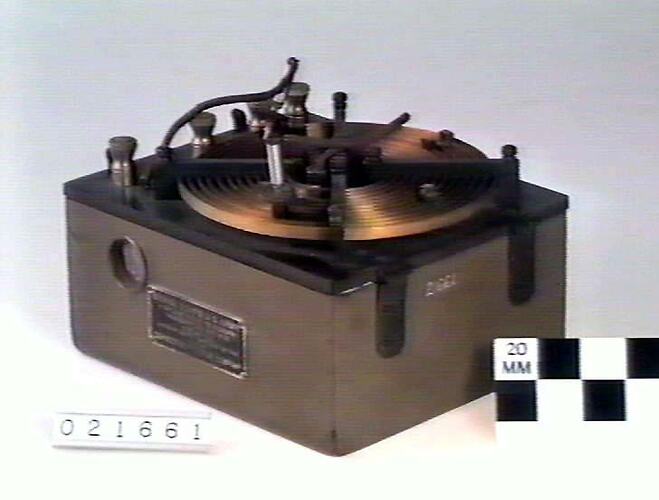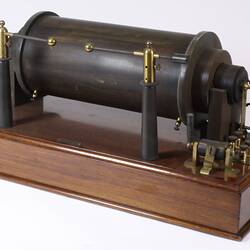Summary
Aircraft type transmitter used by the Royal Flying Corps and Australian Flying Corps during World War I. These transmitters were installed in two-seat reconnaissance aircraft such as the RE.8 used to spot German artillery and troop concentrations and call in artillery fire by morse message. A long 120 foot wire aerial on a reel had to be wound out by the observer to enable transmissions to be sent on the 100-260 metre wavelength. Power was provided by a 6-volt wind powered accumulator providing an output of 30-40 watts.
Physical Description
Rectangular wooden box with hinged ebonite lid. A spiral inductor is mounted on the lid along with four terminals and two moveable clips. A window on one side allows viewing of the spark gap. Instrctions are glued to bottom of box. Clipped to inside of box is abrasive stone for cleaning contacts and the gap, spare spark gap, and a spanner.
More Information
-
Collecting Areas
-
Acquisition Information
Donation from R. St. Clair, 24 Sep 1941
-
Place & Date Used
-
Manufacturer
Connecticut Telephone & Electric Company, Connecticut, United States, circa 1918
-
Inscriptions
Side of box: SIGNAL CORPS, U.S. ARMY. / AIRPLANE RADIO TELEGRAPH / TRANSMITTING SET BOX / TYPE BC-15A / ORDER No 140274. DATE AUG. 22, 1918 / MADE BY / CONNECTICUT TELEPHONE & ELECTRIC COMPANY Top panel adjacent to terminals from left to right: - BATTERY KEY + COUNTERPOISE ANTENNA Inside box - sheet: Operating Instructions for Airplane Radio Telegraph Transmitting Set, Type SCR 65-A / (text and diagrams) Inside box - abrasive stone: No. 53(?) MEDIUM INDEX / MADE IN USA
-
Classification
-
Category
-
Discipline
-
Type of item
-
Overall Dimensions
160 mm (Length), 190 mm (Width), 110 mm (Height)
-
Dimensions
21 cm (Length), 16 cm (Width), 15.5 cm (Height)
Measurement From Conservation. Measuring Method: Closed
-
Keywords
Military Communication, Morse Code, Transmitters, World War I, 1914-1918, Air Forces

